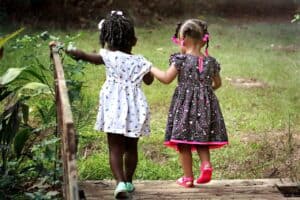Meditation for Kids and Mindful Walking
Seeds of Peace with Thich Nhat Hanh

In 2012, I was fortunate to meet the Zen Master Thich Nhat Hanh at his educator’s retreat. This retreat was dedicated to helping adults make meditation accessible for young people.
Even today, this experience continues to inspire me as I train people to teach meditation. I would come to think of Seeds of Peace with Thich Nhat Hanh, as a moment that changed my life because I had the privilege to walk, breathe, and practice with him.
At the time, mindfulness training in the West was primarily for adults. But Thay (as his students lovingly called him) was a pioneer and determined to encourage educators and other professionals to share these transformative skills with young people. Fortunately, this pioneering concept has now grown globally in schools and homes.
In this blog, I share the impact of this experience on me and my work while bringing you more seeds of peace and practical steps to bring mindful walking skills to the children you care deeply about.
Meditation for Kids – Mindful Walking
At the retreat, many of us were enthusiastic about learning specific techniques to apply in classrooms. But the experience became much more than acquiring skills. Through each session, Thay taught us simple practices that developed our internal compass to peace.
One practice that resonated deeply with me was mindful walking. Initially I had dismissed mindful walking, unsure of how I could practise it without the extra challenge of teaching children who might easily become bored or find it amusing.
Thich Nhat Hanh taught us that mindful walking wasn’t simply a way to transport our bodies, it was an invitation to fully inhabit each moment. Thay gently guided us, outside in the streets of London, reminding us to “walk as if you are kissing the Earth with your feet.”
Mindful Walking with Thich Nhat Hanh
As I began to practice, I felt silly and slightly amused but my ego was determined to ‘keep up’.
Then something changed.
I felt this surge of peace, and gratitude flow through me. I felt emotional for no logical reason and I imagined that it was the energy of love I was feeling as it radiated from Thay. His mindful practice was supporting mine by creating the space for me to tune into the colours, the birds, the sounds, nature and this moment of life.
I felt a joy rise up in me that was unstoppable. I felt tears well up as I continued my walk, overcome with a sense of interconnectedness and gratitude. It was a moment I would carry with me long after I left the retreat—a reminder that peace is always just a step away.
Nurturing Seeds of Peace: Mindful Walking Practice
I had practiced meditation for years, yet Thich Nhat Hanh’s guidance showed me simple and accessible ways to connect with my own inner peace. Walking, a seemingly ordinary activity, became a profound way to be fully present. As I walked with intention, I noticed sensations that often go unnoticed—the feeling of my feet touching the earth, the gentle rhythm of my steps, the breath flowing in and out. I felt each step as a gift, realising how precious each moment could be when lived with awareness.
With each step, we could experience the world in a new way—feeling connected, grateful, and at peace. This act of walking slowly, purposefully, became a meditation in itself, a moving prayer that could cultivate inner calm and gratitude.
It was humbling to realise that my internal peace was most important to cultivate before I could truly share it with others – especially children.
Through my own experiences and research I have since learned that children sense our stress and will mirror it back to us. Cultivating peace within was a priority in order to become a model of peace for young people.
Meditation for Kids and Mindful Walking

I now understood how transformative mindful walking could be, especially for children.
Till this point, meditation was seen as a seated, still practice and this was difficult for young people (so full of energy) to practice.
Instead of simply instructing them to sit quietly, we could invite them to engage in mindful walking. This would help them explore feelings and their energy through movement. Children have an innate curiosity and can be guided to tune into different senses when mindful walking. This helps it to become a natural practice for them with some gentle guidance.
Meditation for Kids – Mindful Walking Tips
- Start with Curiosity: Invite children to notice the world around them as they walk. Encourage them to feel the earth beneath their feet, observe the colours, shapes, and textures around them, and listen to the sounds. Simplify it by giving them this list and asking them to choose what they will focus on first.
- Slow Down Together: Walk with them at a gentle pace, focusing on each step. Practice together, and let them see you taking slow, intentional steps.
- Engage their imagination: To keep their focus, you can guide them to imagine they are an astronaut who has just landed on earth. They are wearing heavy space boots that keep them pinned to the earth and encourage them to slow down their walk as they listen and observe this ‘new world’ around them.
- Breathe with Each Step: Encourage children to take a deep breath with each step, focusing on the feeling of the breath entering and leaving their bodies. One step is an ‘in-breath’ and one step is an ‘out-breath’.
- Adapting the Meditation for SEN: If children have disabilities that mean they cannot walk, you can still take them in their wheelchair to experience the world through their senses. If children are unable to physically go outside, take them there in their imaginations instead.
- Practice Gratitude: Before walking, invite them to think of something they’re grateful for and to imagine the feeling becoming clearer with each step. It could be feeling grateful for being alive, being able to use their legs/feet, being safe/warm, or even to thank the earth beneath them as they walk. You could explain that the trees around them give them the air that they breath. This brings a sense of connection and appreciation.
- End with Reflection: After a few minutes, gather and ask the children how they feel. Encourage them to notice any sense of calm or happiness they experience.
In these simple ways, we can help children nurture their own seeds of peace in every step they take.
Mindful Walking in Gratitude
Thich Nhat Hanh’s message was clear: we must first care for ourselves if we want to truly support others.
Mindful walking taught me that caring for ourselves doesn’t require elaborate routines; it can be as simple as taking a mindful step, breathing deeply, and expressing gratitude. Walking can become a sacred practice, reminding us that we are connected to the world and each other.
Meditation for Kids and Mindful Walking: Home practice
- Invite children to choose where you walk. Mindfully chat about how we are fortunate to have a healthy body that easily takes us from one place to another.
- When you reach the space, set a timer with a bell so that when they hear the bell (and their minds are distracted) they remember to take a deep breath and notice what’s around by using one of their 5 senses.
- Invite them to stop at one point, eyes closed and use a different sense to experience the world around them.
- Use their imagination as suggested above, or ask them to imagine different ways they could walk that would slow them down so they can tune in to the world around them.
- Invite them to teach one of their friend’s how to mindful walk.
- Invite them to teach and guide you how to walk mindfully.
Schools – Mindful Walking Practice
If you would like to learn more about mindful walking practices for schools, please connect with us (below) and we’ll share a mindful walking practice that can be incorporated into school routines.
We’ll be releasing more information in our next blog post about the different techniques shared on this retreat. Please follow us on social media to be kept informed.




